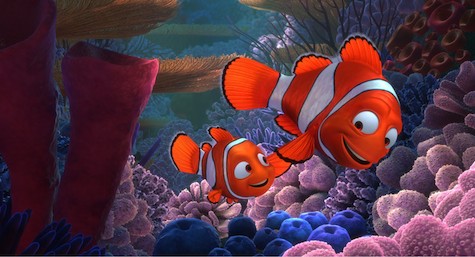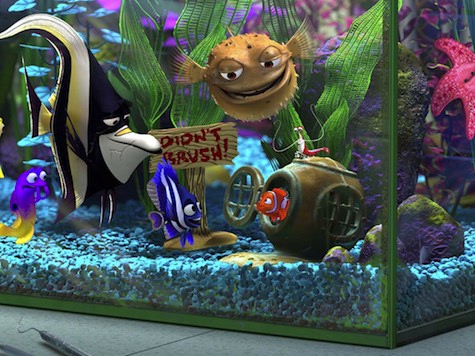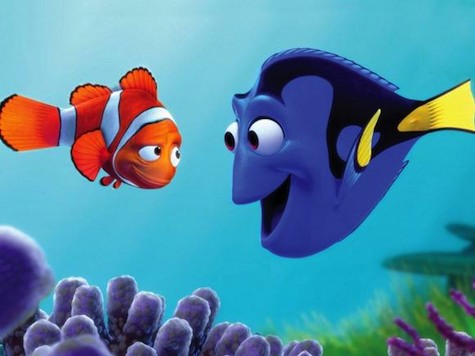For years, bath time was Finding Nemo time.
Dory would say some silly things and forget where she was going. Marlin would worry. And Crush would take them both on a totally bodacious ride. Nemo always just got to have fun, jumping through rings or helping to say the sounds of the foam letters clinging to the bathtub wall.
Finding Nemo hit theaters when my son – our first child – was 2 ½ years old. It was the first movie we took him to see, and it terrified me.
The tragedy of the opening sequence in the movie colors everything that follows. Reportedly, an earlier version of the Finding Nemo story wove a flashback structure into the narrative, and the truth about Marlin’s loss didn’t become clear until later. In director Andrew Stanton’s final version, the death of Marlin’s wife and yet-to-be-born children is the gut-punch that begins the film. Marlin’s overprotective, panicked nature is understandable. He has lost everything, and only little Nemo survives. His last tiny piece of family.
Finding Nemo builds upon the ultimate parental fear: that something will happen to the kids. And it also taps into that most frightening aspect of a child’s life: being lost, far away from home, in a strange place. These are the kinds of things nightmares are made of.
And here’s Andrew Stanton, making an action-packed comedy with the stuff of those nightmares.
That’s the genius of Finding Nemo, of course, and as funny and thrilling as the movie can be, it retains its dark edge throughout, no matter how colorful the undersea landscapes remain.
Like most Pixar films, Finding Nemo is a story about trying to get back home. While many traditionally-animated Disney films emphasize exploration and adventure, as the young hero or heroine ventures out into a world fraught with danger, the bulk of Pixar productions seem more interested in saying, “sure, there’s plenty of excitement out there, and you’ll learn something important, but let’s just get back home where we’re safe.”

It’s the eternal heroic quest structure, the well-worn Joseph Campbell pathway into the unknown world and back again. But like that most ancient of examples, The Odyssey, it’s the voyage home that matters. Everything else just gets in the way.
But there’s more to Finding Nemo than just a classical structure and an emotional core built on the deepest-rooted of all parent-and-child fears. Andrew Stanton and the Pixar crew don’t stop there (though they could have, and it still would have been better than most films of this kind). Instead, they populate their underwater world with vivid characters, memorably-designed, well-written, and performed with immediate charm.
Albert Brooks centers the film, with his tentative Marlin, the father who braves the fiercest dangers because it’s the only thing he can do to save his son. It’s a Brooksian performance but not a traditional Brooks role. This character has Brooks’s usual cadence, but without the knowing confidence that underlies his sometimes-hesitant delivery. There’s always an honesty underneath Brooks’s biting wit in other roles, but he’s never as vulnerable as he is as Marlin. This is a fragile, fractured lead character, but Brooks keeps him from seeming pathetic. He’s a tiny heroic clownfish, against all odds.
When she performed as the frantic and scatter-brained Dory, Ellen DeGeneres wasn’t the cultural force she has since become. Her talk show launched the year Finding Nemo was released to theaters, and her voice work in the film seemed like a comeback only a couple of years after her fizzled sitcom career. As Dory, she’s a wonderful foil for Marlin, not because she plays the wise mentor who guides the hapless father (which, by Campbellian structuralism, is what her role should be), but because her seeming incompetence pushes Marlin to take charge. And pushes him to engage with the world around him, in a way that he hadn’t since the death of his wife.
The other characters provide amazing texture throughout Finding Nemo‘s running time. The Willem Defoe character alone, the troubled Gill, has gravitas and pathos enough to fill the story with depth. At first he seems like a grown, cynical parallel version of Nemo, but he reveals himself to be much more complex – an alternative father figure for the young clownfish, with a grave but gentle bearing. And yet, he’s just a pet in a dentist’s fish tank. But under Stanton’s direction, it’s like something out of Sophocles.

I could go on, listing the variety of engaging supporting characters like Bruce the shark, and Crush the sea turtle, or the enthusiastic Mr. Ray, but once we start heading down that path, we’d be talking about every single minute of the movie, and you’re better off just watching it yourself, no matter how many times you’ve seen it before.
In the end, our aquatic Odysseus heads home with his son, to the safety of the anemone. But this time, it’s not out of a desperate need to prevent the intrusion of the outside world and the dangers it represents. It’s because they know what’s out there – and they know they can handle it – but home is where they would rather be. We know it can’t last forever. Nemo will be out on his own soon, and Marlin will be better prepared to let him go.
My own son, that former-toddler who saw Finding Nemo while just out of diapers, is just a few days from 5th grade graduation. He’s going to be 12 this year, already a teenager in all but the technicalities of the numbering. He’s off to middle school in the fall, and before I acclimate to that, he’ll be in high school, and then college, and then…
Well, the world awaits.
And though I’ll always worry, and I’ll always be there to help, I won’t stand in its way.
Thanks Andrew Stanton and Pixar. Thanks Marlin and Nemo. Your journey has meant more to me than you could possibly know.
Tim Callahan usually writes about comics for Tor.com, but he also spends an estimated 850 hours a week as a husband and father.










